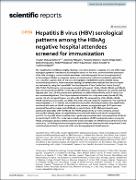| dc.description.abstract | The Hepatitis B virus (HBV) is a highly infectious virus and is endemic in Uganda. It is one of the major
etiological agents for liver diseases including liver cancer. In this work, we evaluated the prevalence
of the HBV serological markers and the associated socio-demographic factors among hepatitis B
surface antigen (HBsAg) seronegative persons screened during routine immunization against the
virus in eastern Uganda. Data on the socio-demographic characteristics were collected using a
structured questionnaire, while that on the serological markers were obtained from serum samples
and evaluated by using the 5-panel HBV One Step Hepatitis B Virus Combo Test Device (
FastepR,
HBV-P43M). The following markers were evaluated by the panel: HBsAg, HBsAb, HBcAb, and HBeAb.
Data were analyzed using SPSS (version 26), and multinomial logistic regression was used to elicit the
adjusted odds ratio. All the analysis were performed at a 95% confidence limit, and a P value ≤ 0.05
was considered significant. The 424 participants included in this study were mainly female (62.3%),
married (55.4%) and aged 30 years and above (54.2%). The seropositivity of the HBsAb, HBeAb,
HBcAb marker prevalence rates was 48(11.3%), 73(17.2%) and 45(10.6%) respectively. The majority of
the participants (327, 77.1%) did not present with any marker. Married paricipants were significantly
associated with reduced HBsAb seropositvity rate, whereas young people aged 18–29 years were
associated the with increased odds of HBsAb seropositivity (p < 0.05). Male participants were
significantly associated with the HBeAb and HBcAb seropositivity (p < 0.05). Similarly, contact
with an HBV infected person was significantly associated with HBeAb and HBcAb seropositivity
(p < 0.05). Further still, blood transfusion was significantly associated with the increased risk of HBcAb
seropositivity (P < 0.05). This study has revealed a prevalence of HBV serological markers among the
HBsAg seronegative persons in this community and an increased risk of transmission of the virus in the
community. Our findings have key consequences pertaining the interventions that are pertinent in the
control and prevention of the spread of the virus among apparently health persons.
Hepatitis B virus (HBV) is the causative agent for liver inflammatory diseases, which, if not diagnosed in a timely
manner and subsequently managed, are likely to progress to chronic liver diseases, liver fibrosis, liver cirrhosis,
and liver cancer1.
The virus has been implicated as one the most common oncogenic virus in humans2.
It is a
highly transmissible virus and is 50 to 100 times more infectious than Human Immune deficiency Virus (HIV).
In addition, it has extreme resilience, allowing it to survive for several days on dry surfaces. This complicates
its epidemiology and explains the increased chances of intra-familial horizontal transmissions3.
Despite the presence of a safe and highly efficacious vaccine, HBV infection is still one of the major global health problems4.
The Uganda Population-Based Impact Assessment (UPHIA) 2016–2017 survey reported a drastic decrease in
the prevalence of HBV in Uganda5.
According to this survey, the national prevalence of HBV dropped from
10% in the general population in 20156
to 4.3% in 2016 and 4.1% in 2017, with east-central posting a prevalence
of 2.1%. However, HBV is a chronic infection and these data are suggestive of either massive death of the
chronically infected persons or a higher level of sero-conversion to HBsAb between the sampling intervals.
Nevertheless, the rapid sero-conversion indicated by a high prevalence of the HBsAb with normal levels of the
correlates of liver damage over a short period of time seems to be unrealistic. Similarly, the drastic decrease in
the risk of infection because of improved immunity or public health awareness appears idealistic. The relative
importance of the socio-demographic factors to HBV infection varies from population to population7,
and their
contribution to community spread of HBV have been previously reported with concordance in some studies
and contradictions in other studies8–
12. Understanding these sociodemographic factors related to infection and
their relationship with markers of HBV exposure will provide plausible answers to the recent drastic decline in
HBV in Uganda. To understand the sero-prevalence of hepatitis B virus, screening of a large number of people
is needed. Serological markers for detection of HBV are diverse13
and include hepatitis B surface antibody
(HBsAb), hepatitis B pre-core antibody (HBeAb), hepatitis B pre-core antigen (HBeAg), hepatitis B core antibody
(HBcAb) and hepatitis B surface antigen (HBsAg). However, in resource limited settings, screening for hepatitis
B virus infection is limited to only the HBsAg using the rapid diagnostic test. Unfortunately, the use of a single
marker of exposure is associated with vast irregularities in the diagnosis of HBV. This inconclusive diagnosis is
likely to mislead clinicians in their decisions when managing the HBV-infected persons as well as the decision
to discard donated blood for transfusion by local and regional blood banks. HBV exposure markers have high
sensitivity but low specificity, justifying the need to investigate them not in isolation for comprehensive case
management and explicit assessment of blood for transfusion. The Anti-HBc is characteristic of a hidden HBV
carrier state and/ or resolved disease14.
Anti-HBs antibodies are associated with acquired immunity either due to
previous exposure and natural response to the virus or due to vaccination15,
whereas the Anti-HBe antibody is a
marker of the minimally infective phase and disease remission or recovery from the infection16.
Thus, as eluded
from above, the relative significance of different sociodemographic risk factors for infection, the comparative
expression of markers of liver damage and the relative prevalence of different markers of exposure to HBV at the
community level can provide constructive clues on the trend of HBV prevalence and infectivity in a population.
Consequently, we sought to understand the current state of the risk factors for HBV infection and the prevalence
of the markers of immunity against HBV among HBsAg seronegative individuals to justify the drastic reduction
in the burden of HBV in Uganda. | en_US |

